编者按:德国联邦自然保护局(BFN)风景园林规划、空间规划、城市发展部主任Florian Mayer先生于2016年5月在柏林举行的“中国可持续城市——大城市解决方案”大会上做了“城市绿色基础设施:规划和实施的战略方法”的报告。本文立足于德国的风景园林规划经验,详细介绍了绿色基础设施的概念、内涵、发展和应用,为我们正在经历的新型城镇化背景下的风景园林发展提供了有益经验。在此,感谢Mayer先生为风景园林新青年提供演讲文件并专门撰文介绍。
译者:牛加翼,YouthLA志愿者,北京林业大学风景园林专业本科,法国洛林大学景观环境专业研究生。
2013年,绿色基础设施欧洲战略被采用,并明确地涉及到城市空间。在欧盟层面,绿色基础设施的概念已经根植于欧盟生物多样性战略中,因而明确地提到自然保护。在我们的理解中,城市自然保护包括物种和栖息地保护(生物多样性),非生物资源的保护比如水、空气和气候(生态系统),以及社会层面,包括社会和文化方面(生态系统服务)的保护。我们能够很容易地认识到对城市自然的重建所做出的贡献在自然和人类健康上所造成的影响。
在德国,为之所做的努力已经成功地扎根于城市自然问题的政治战略文件中——国家生物多样性战略。自2007年来制定了城市景观的愿景、目标和措施。以环境、自然保护、建设与核安全(BMUB)为目的的德国联邦自然环境署-自然保护运动2020将“绿色的城市体验”作为自然保护行动十大优先课题之一。最后,联邦倡议“城市中的绿色 – 一个宜居的未来”还强调了生物多样性和城市生态系统多方面服务对城市可持续发展的重要性。 2015年,绿皮书“城市中的绿色”由BMUB提出,2017年,措施完备的白皮书将随之跟进。
联邦自然保护局的活动包括大范围的研究、实施和交流项目,其中一个重要的课题是内城城市发展的评定。高土地利用率的传统模式下的欧洲密集型城市为了生物多样性,使用其他开放空间。一方面,高人口密度意味着低人均土地面积——比生活在郊区或农村地区的人要低得多;另一方面高密度的人口和基础设施对生物多样性和城市里面的居民带来了压力。因此城市绿化区域和建成区之间的平衡是必要的。这可以通过实施我们称之为“双内城发展”的概念来实现。它在现有的高密度建成区的基础上,保留并提高了绿地和开放空间的数量、质量以及可用性,并增强了其他绿地基础设施,例如行道树,绿化墙和绿化屋顶。这种策略减少了土地占用并保护了定居点外的开放的景观。同时它提高了城市内部绿地的数量、质量和可达性。
总之,在应对当前诸如气候变化、人口变化等挑战的背景下,城市自然提供了重要的生态系统服务并发挥了关键的作用。结构良好的城市为许多动物和植物物种提供了栖息地。绿色空间的存在是城市生活质量的一个决定性因素。对于很多人来说城市绿地空间是与自然和生物多样性相接触的唯一渠道。
绿色基础设施的概念可以帮助我们提高对城市自然的认识并且整合环境更好地融入城市发展。为了绿色基础设施的应用,自然保护和城市发展合作的新方法是必要的。这包括从国家到地方的各个层面。
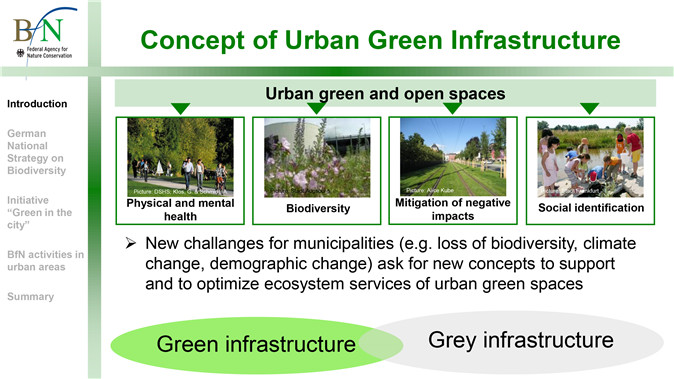
Image1:城市绿色基础设施概念:
市政的新挑战(生物多样性丧失、气候变化、人口增长)需要新的概念去支撑并优化城市绿地的生态系统。鉴于城市绿地和开放空间有益于物质和精神健康、改善生物多样性、减少负面影响以及增加社会认同感。所以与灰色基础设施概念相对的绿色基础设施概念应运而生。
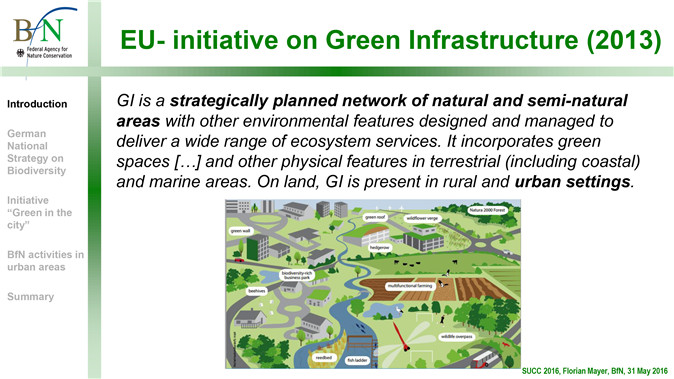
Image2:绿色基础设施的内涵
绿色基础设施是在自然和半自然地区的战略性规划网络, 它结合了其他环境特征,以提供更广泛的生态服务。它包含了陆地和海洋(海岸)地区的在内的绿地空间。就陆地而言,绿色基础设施主要存在于农村和城市区域。
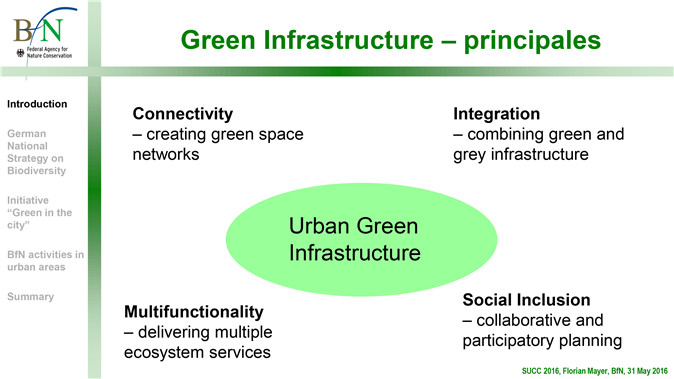
Image3: 绿色基础设施的四大原则
连接性:创建绿色空间网络
整合性:链接绿色和灰色基础设施
多功能性:提供多种生态系统服务
社会包容性:合作与参与式规划
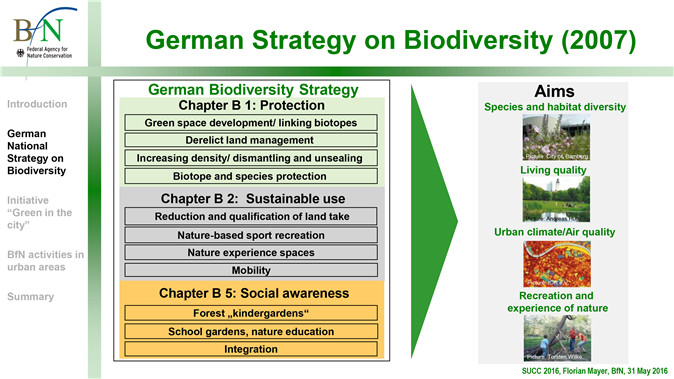
Image 4:德国生物多样性战略
从保护、可持续利用、社会意识等方面达到整和生境多样性、改善生活质量、城市气候/空气质量和自然的娱乐与体验的目标。
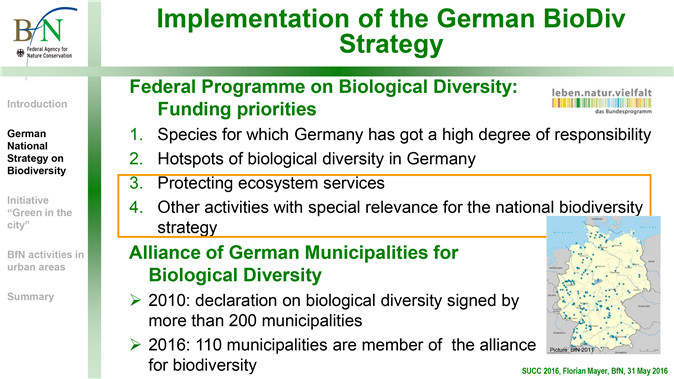
Image5:德国生物多样性战略的实施
保护生态系统服务和其他与国家生物多样性战略有特殊相关性的活动已被列入德国生物多样性战略中。
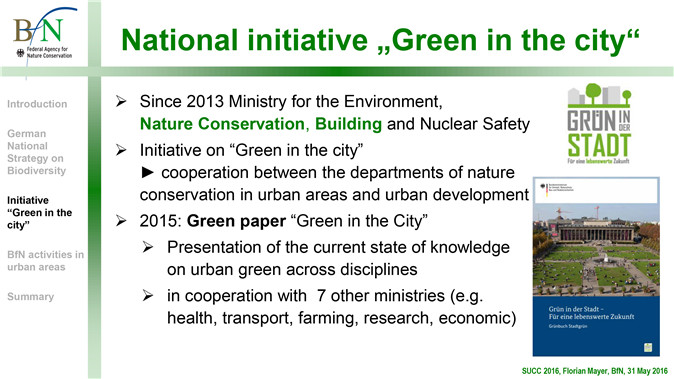
Image6:“城市中的绿色”联邦倡议的实施
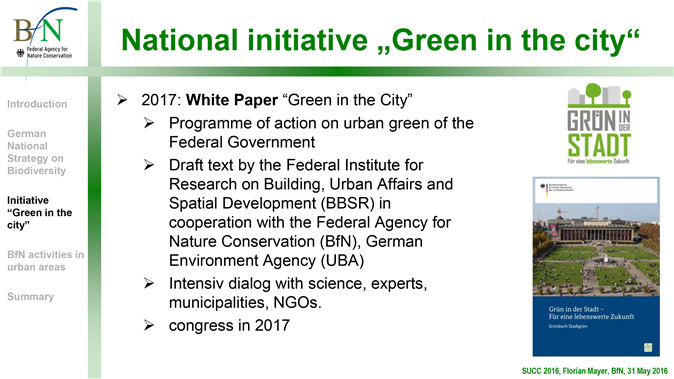
Image7:“城市中的绿色”联邦倡议的实施
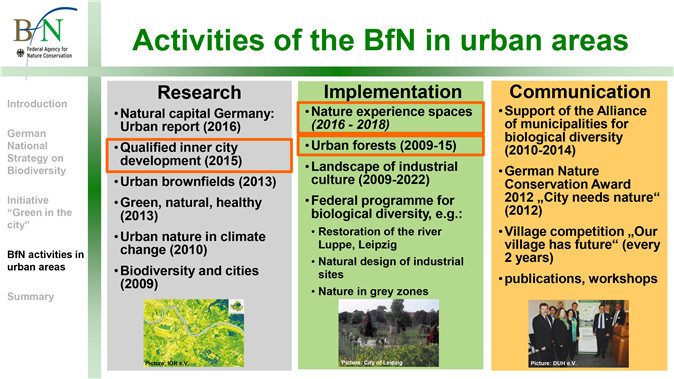
Image8:联邦自然保护局的研究、实施和交流项目
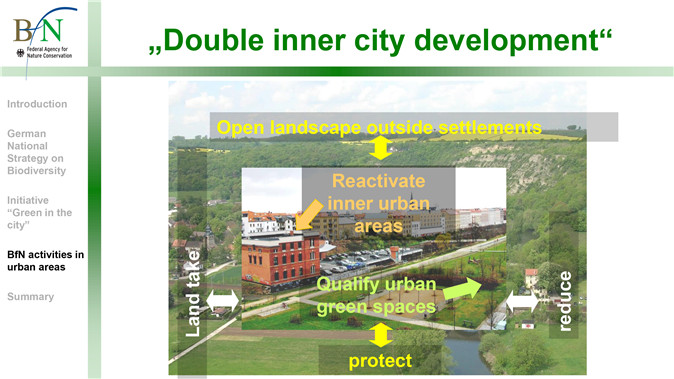
Image9: “双内城发展”图示
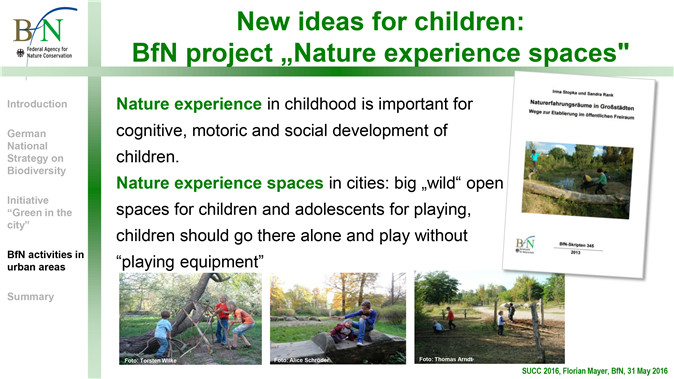
Image10:为了儿童的新计划:联邦自然保护机构“自然体验空间”项目。
自然体验对儿童的认知、运动和社会发展非常重要。城市自然体验空间给儿童和青少年提供了巨大的“野生”开放空间,儿童需要在这里玩耍而不是依靠游戏器械。
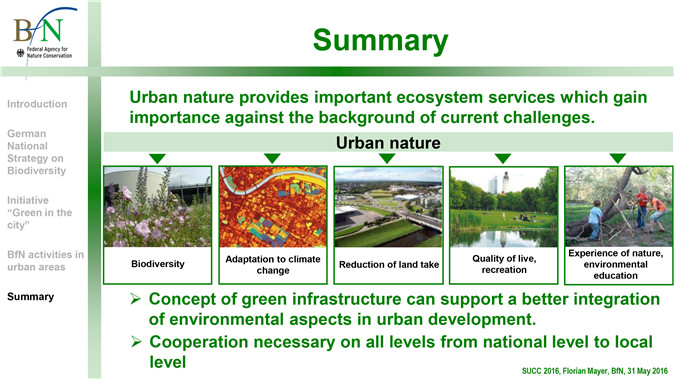
Image11:总结:城市自然环境提供了重要的生态服务,它在当下各种挑战的社会背景下起到重要作用。
Sustainable Urban China – Metropolitan Solutions 2016 Berlin, May 2016
Title: Urban green infrastructure: strategic approaches to planning and implementation
Authors: Florian Mayer
Institution: Federal Agency for Nature Conservation (BfN), Germany,
Department Landscape Planning, Spatial Planning, Urban Development
In 2013 the European Strategy on Green Infrastructure was adopted. It explicitly involves urban spaces. At EU level, the concept of green infrastructure is embedded in the EU Biodiversity Strategy, and thus has a clear reference to nature conservation. In our understanding, nature conservation in the city includes ecological approaches of species and habitat protection (biodiversity), the protection of abiotic resources such as water, air and climate (ecosystem) and also societal, social and cultural aspects (ecosystem services). The contributions of urban nature to recreation, experience of nature and human health can be recognized easily.
In Germany, efforts have been successful to anchor issues of urban nature in strategic political documents: The National Strategy on Biodiversity from 2007 formulated a vision, aims and measures also for urban landscapes. The Nature Conservation Campaign 2020 of the Federal Ministry for the Environment, Nature Conservation, Building and Nuclear Safety (BMUB) identifies “Experience of green in the city” as one of ten prior fields of action of nature conservation. Last but not least the Federal initiative “Green in the city – for a livable future” of BMUB highlights the importance of biological diversity and the manifold services of urban ecosystems for sustainable urban development. In 2015, the green book “Green in the city” was presented by BMUB and in 2017 a white book with measures will follow.
The activities of the Federal Agency for Nature Conservation comprise a large range of research, implementation and communication projects. An important topic is the qualification of inner city urban development. The traditional model of a compact European city with efficient land use protects open space for biodiversity elsewhere. High population densities imply a low amount of ground area per capita — much lower than for people living in suburban or rural areas. On the other hand a high density of people and infrastructure puts stress on biodiversity and on people inside cities. Therefore a balance between urban green and built up areas is necessary. This can be achieved by implementing the concept of what we call ‘double inner city development’.It combines the densification of existing built up areas with a mixture of conserving and increasing the amount, quality and usability of green and open spaces, and with enhancing other green infrastructure such as trees on streets, and green walls and roofs. This strategy reduces land take and protects open landscape outside settlements. At the same time it improves the amount, quality and accessibility of green areas inside the city.
In summary, urban nature provides important ecosystem services which gain importance against the background of current challenges such as climate change and demographic change. Well-structured cities offer habitats for many animal and plant species. The existence of green spaces is a decisive factor for living quality in cities. For many people urban green spaces serve as the single contact with nature and biological diversity.
The concept of green infrastructure can help to raise the awareness for urban nature and can support a better integration of environmental aspects in urban development. For the implementation of green infrastructure new ways of cooperation between nature conservation and urban development are necessary. This includes all levels from national to local level.

